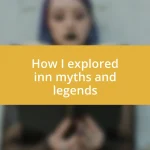Key takeaways:
- Begin your journey of discovering hidden historic gems with curiosity and a specific focus, like local folklore or architectural styles.
- Engage with local communities and historians to deepen your understanding and uncover unexpected treasures.
- Document your discoveries through journaling, photography, and sharing on social media to preserve and connect with the history you explore.

How to start your journey
Embarking on a journey to discover hidden historic gems begins with curiosity. When I first stumbled upon an old, forgotten cemetery during a weekend hike, I felt an exhilarating spark of intrigue. That moment made me realize—how many stories lie beneath our noses, waiting to be uncovered?
Next, I suggest choosing a specific focus that resonates with you. Whether it’s the architecture of historic homes or the folklore of a particular town, having a direction can transform the search into a fulfilling quest. For instance, when I started exploring local ghost stories, my adventures led me to uncover fascinating buildings that shaped my community’s identity.
Lastly, don’t hesitate to connect with local historians or join community groups. I remember attending a lecture by a passionate historian who inspired me to research my town’s roots further. It’s amazing how sharing your interest with others can deepen your understanding and multiply your chances of unearthing those hidden treasures. Have you thought about who might share your passion for history? Engaging with others can lead to unexpected discoveries.

Choosing the right locations
Choosing the right locations is crucial for uncovering hidden historic gems. I’ve learned that venturing into uncharted territory often provides the richest rewards. A few years back, while wandering through a sleepy village, I stumbled upon an abandoned schoolhouse. The dilapidated structure whispered stories of children who once filled its halls, sparking my passion for uncovering similar stories throughout my travels.
When selecting locations, consider areas with deep-rooted history or unique architecture. I once opted to explore a small town known for its annual heritage festival. Little did I know, the winding streets would lead me to a century-old chapel, hidden behind overgrown ivy, that had played a pivotal role in the town’s history. That serendipitous encounter reinforced my belief that some of the best finds are often tucked away in unfamiliar places.
Another tip is to pay attention to local legends and less-traveled paths. I recall a friend telling me about an old mill rumored to be haunted. Honestly, I was skeptical at first, but visiting the site opened my eyes to its beauty and historical significance. The intriguing combination of myth and reality heightened my excitement, proving that sometimes, a little folklore can guide you to true treasures.
| Location Type | Example |
|---|---|
| Abandoned Structures | Old Schoolhouse |
| Historic Towns | Heritage Festival Town |
| Local Legends | Haunted Mill |

Researching historical significance
Researching the historical significance of a site can be both thrilling and insightful. I remember a rainy afternoon when I delved into local archives, flipping through dusty pages of old newspapers. Each article revealed snippets of life from decades past—like the story of a forgotten artist whose work initially went unnoticed but later shaped the cultural fabric of my town. It felt as though history was coming alive, urging me to discover more about the people and places that shaped our heritage.
When researching, it helps to be methodical. Here are some approaches I’ve found effective:
- Visit Local Libraries and Archives: They often house unique collections of documents, photographs, and personal letters.
- Utilize Online Databases: Websites like the National Archives or local historical societies can be treasure troves of information.
- Consult with Elders or Long-time Residents: Their memories and anecdotes can provide firsthand accounts that bring history to life.
- Examine Local Folklore: Stories passed down through generations often hint at deeper historical truths.
- Explore Historical Maps: They can reveal how areas have changed over time and may locate sites of interest that are no longer prominent.
In my experience, combining these resources enriches your understanding and allows you to appreciate the hidden narratives that surround us. Each stone you turn over in your research could lead to an unexpected gem waiting to be discovered.

Techniques for uncovering gems
Exploring old maps always feels like opening a time capsule for me. I vividly recall an afternoon spent at a dusty second-hand bookstore, thumbing through stacks of forgotten atlases. One particular map from the 1800s caught my eye—it illustrated ghost towns in my region that no one really talked about anymore. This led me on a spontaneous road trip to locations that were barely marked on modern maps. Each visit turned up not just remnants of structures, but layers of history that breathed new life into what I thought I knew about my hometown.
I’ve also found that engaging with the local community can yield surprising insights. A few years back, I participated in a town hall meeting and ended up bonding with an elderly gentleman who shared remarkable tales about the vibrant lives once lived in the historic district. He drew vivid portraits of people transforming a crumbling building into a community center decades ago. Listening to his anecdotes helped me appreciate the emotional connection others have to these locations, enhancing my own explorations. Have you ever spoken to someone who can take you back in time with their stories? It’s like looking through a window into a different era.
Utilizing technology has become an invaluable part of my gem-hunting toolkit. I often rely on apps that document historical sites and share user-generated content about hidden treasures. During one of my urban explorations, I discovered a little-known park featuring sculptures by a local artist who had faded into obscurity. I was astounded by the creativity that flourished right under my nose. It made me think—what else might be just beyond our line of sight if we only take the time to look deeper? I’ve learned that combining old-fashioned techniques with modern tools can truly amplify the experience of uncovering historic gems. The hunt itself becomes an adventure, merging the past with the present in unexpected ways.

Tools for successful treasure hunting
When it comes to treasure hunting, having the right tools can make all the difference. I remember investing in a reliable metal detector, feeling a surge of excitement as I unpacked it. The first time I used it, I scoured an old field rumored to hold the remnants of a long-lost settlement. Hearing that beep resonate in my ears felt exhilarating—it was like the very ground was whispering secrets to me. Have you ever felt that thrill of discovery?
Aside from gadgets, my true treasure lies in documentation tools. I often carry a notebook to jot down thoughts, sketches, or anything intriguing I find during my adventures. One day, while hiking through a forgotten trail, I sketched an old stone wall I stumbled upon. Later, looking back at my notes, those simple lines reminded me of the stories that wall could tell. Don’t underestimate the power of writing; it helps you connect with the narrative threads of history and reflect on your journey.
Photography is another indispensable tool. Capturing images of sites I consider significant allows me to preserve moments that might otherwise fade. I still cherish a photograph I took of an abandoned train station bathed in golden sunlight during the golden hour. Each time I look at it, I’m reminded of the stories held within its crumbling walls. Does it ever inspire you to freeze a moment in time? I believe that blending creative expression with historical exploration enriches the whole experience and ensures those hidden gems don’t fade from memory.

Documenting your discoveries
One of the most rewarding practices I adopted is keeping a detailed journal of my discoveries. I remember a rainy afternoon when I decided to document my findings from a dilapidated mill that I had stumbled upon. With each page, I poured out not just descriptions of the site but also my feelings—how the sound of the wind through the broken windows felt haunting yet beautiful. Have you ever written down an experience that made you feel alive? Reflecting on those moments helps me relive them, deepening my connection to the history I’m uncovering.
As I explore, photographs play a vital role in how I record my adventures. I once visited a nearly forgotten cemetery, where time stood still amidst weathered gravestones and gnarled trees. Capturing the intricate carvings and the way the light filtered through the branches felt like capturing a piece of the past. Each image tells a story, serving as a visual anchor to the memories of that place. Don’t you think a single photograph can evoke emotions that words sometimes can’t? I often look back, and it rekindles the essence of my journey, ensuring that those hidden histories continue to resonate.
In this digital age, I’ve also embraced the power of social media to share my findings with a broader audience. After rediscovering an old tavern that had once served as a communal hub, I posted about it along with my pictures and stories. The response was astonishing! Was it just me, or did it feel like a shared trip through time? Gathering insights and comments from others made me realize the community aspect of these discoveries—the way we connect over shared history can really make these gems shine even brighter. I find that documentation is not just about recording; it’s about building a legacy of shared curiosity and exploration.















